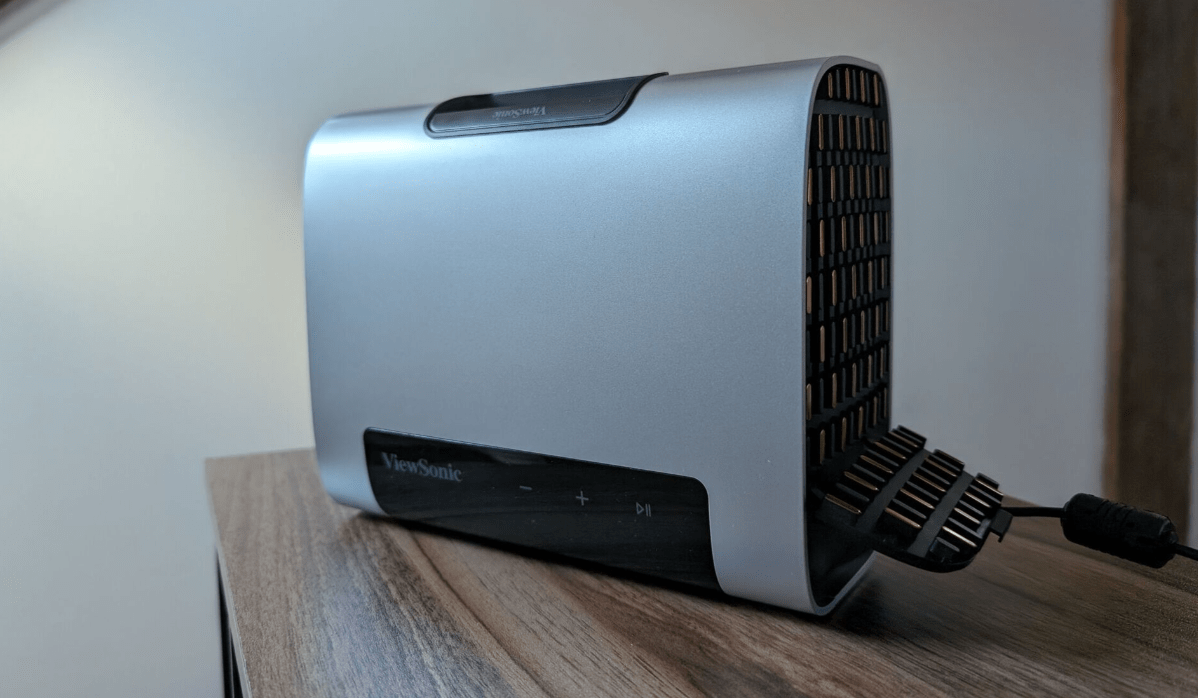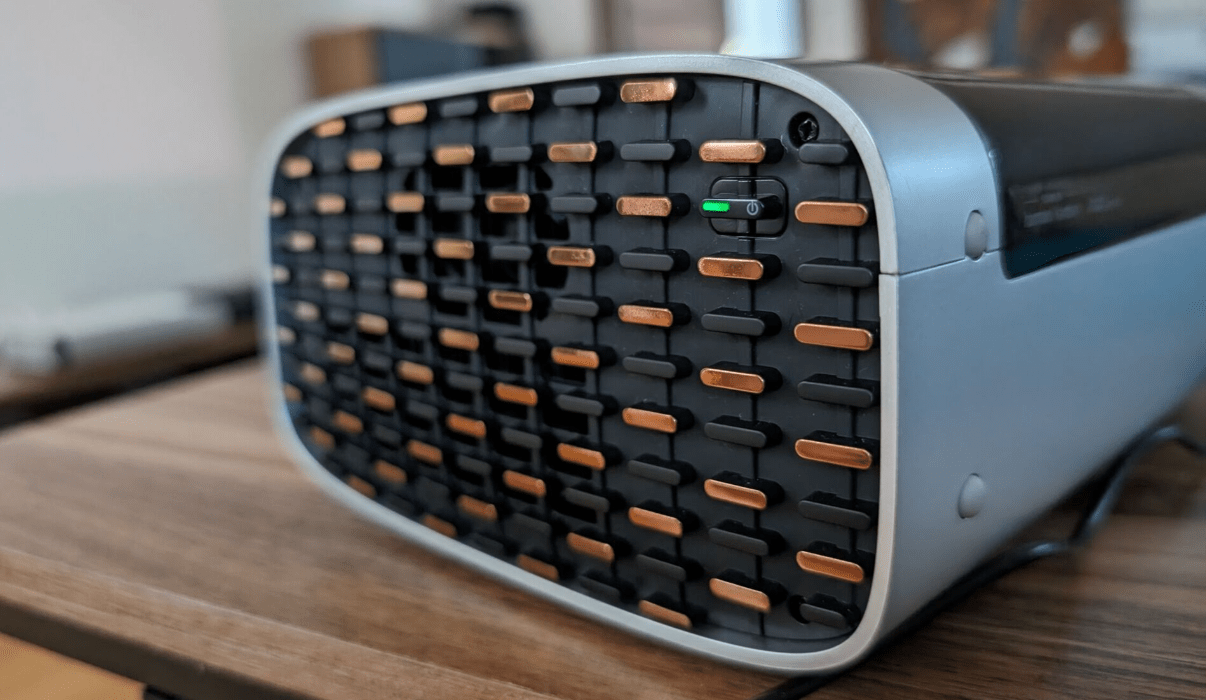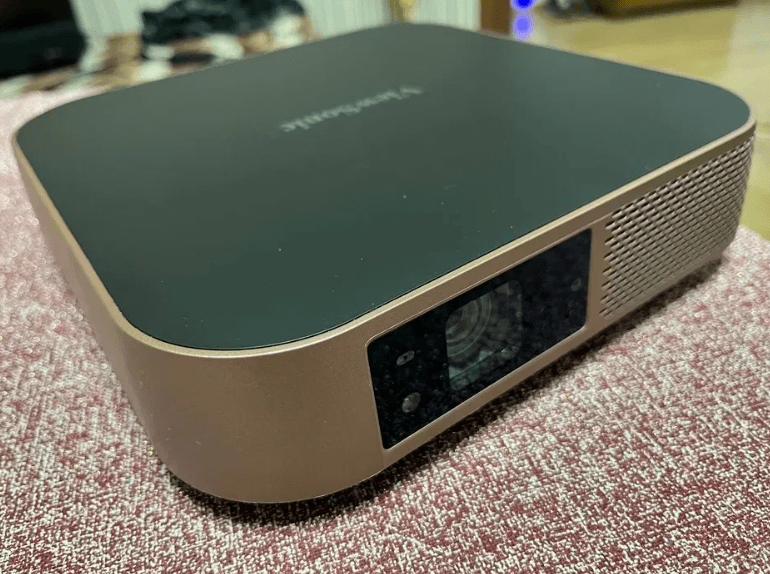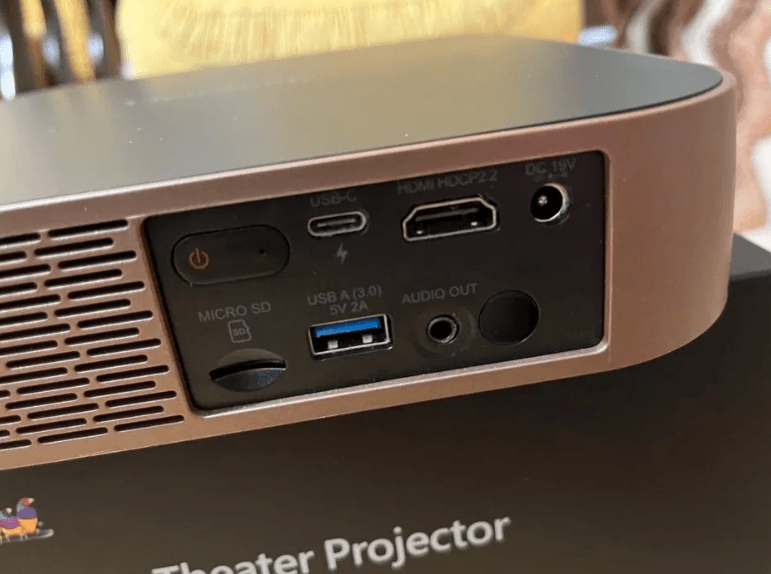At gagadget.com, your trust is our priority. We follow strict quality standards in our research, tests, and analysis of video projectors, to give you the best experience. Learn more
Viewsonic M10 vs Viewsonic M2: Comparison
Hey everyone, Jim's here. Today we're taking an in-depth look at two compact, feature-packed projectors from ViewSonic: the new M10 laser projector and the popular M2 LED model. Both offer 1080p resolution, auto focus, built-in streaming, and integrated Harman Kardon audio in highly portable designs. But there are also key differences in light source, brightness, color, and more. I've put both through their paces to see which one comes out on top!
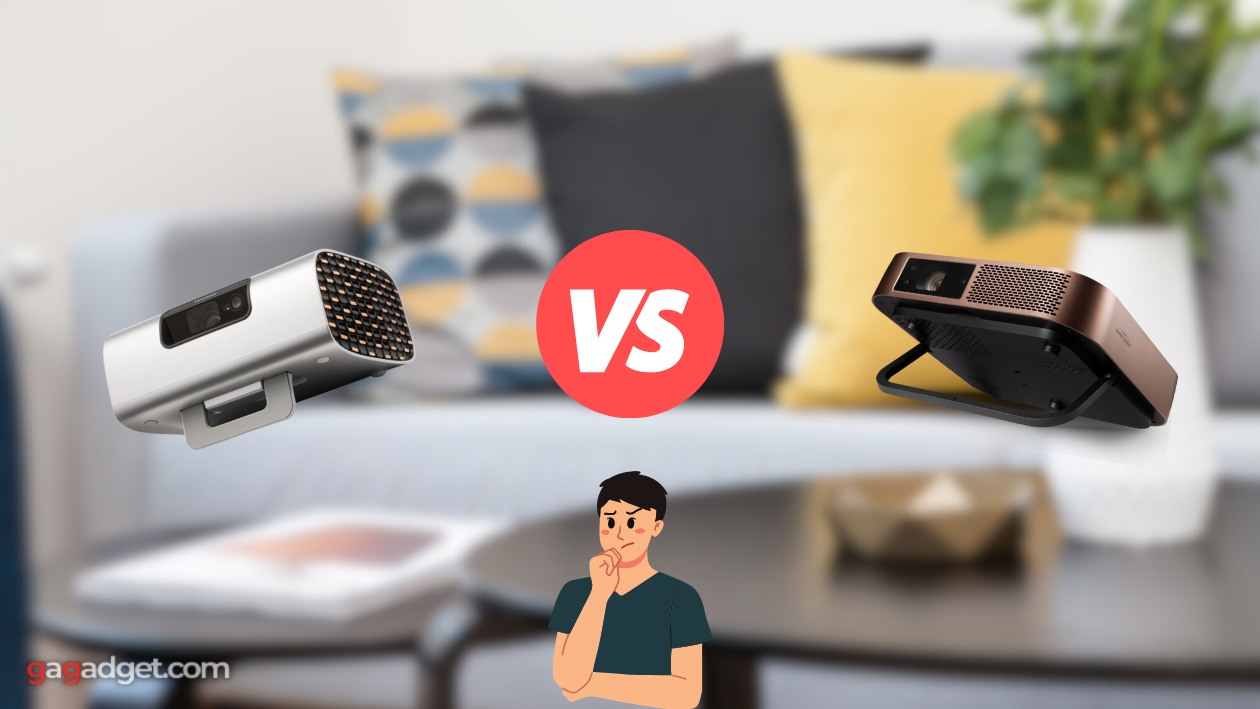
ViewSonic M10 vs M2: Quick Overview
If you're short on time, here are the main talking points: The M10 is ViewSonic's latest portable projector, sporting an advanced RGB laser light source. This allows it to achieve an impressive 2,200 ANSI lumens brightness and a wide BT.2020 color gamut with over 1 billion colors. It also has a longer 20,000 hour lifespan.
The older M2 uses a standard LED light source, producing a more modest 500 ANSI lumens but with an even lengthier 30,000 hour rating. Its color coverage is more limited to the Rec.709 space.
Both offer 1080p resolution, auto focus, auto keystone, integrated Harman Kardon speakers, and wireless streaming via Wi-Fi and Bluetooth. The M10 adds a USB-C port for connecting the latest phones and laptops.
For most buyers, I recommend the ViewSonic M10. The RGB laser, higher brightness, wider color, and USB-C are worth the extra cost for a more vivid, punchy image and enhanced flexibility. But if you mostly watch in dark rooms and want to save a bit, the M2 remains a great affordable pick.
Table of Contents
- ViewSonic M10 vs M2: Full Comparison
- ViewSonic M2 vs M10: Design
- M10 or M2: Owner Reviews
- ViewSonic M10 and M2 Alternatives
- Which ViewSonic Projector is Best, M10 or M2?
ViewSonic M10 vs M2: Full Comparison
| Specs | ViewSonic M10 | ViewSonic M2 |
| Image |

|

|
| Resolution | 1920 x 1080 (Full HD) | 1920 x 1080 (Full HD) |
| Brightness | 2,200 lumens (ANSI) | 500 lumens (ANSI) |
| Light Source | RGB laser | LED |
| Light Source Life | 20,000 hours | 30,000 hours |
| Color Coverage | BT.2020 (100%) | Rec.709 |
| Contrast Ratio | 3,000,000:1 | 3,000,000:1 |
| Throw Ratio | 1.20 (distance:width) | 1.23 (distance:width) |
| Zoom | 0.8x - 1.0x (digital) | 1.0x (fixed) |
| Image Size | 40" - 180" | 24" - 100" |
| Input Lag (1080p/60Hz) | 176ms | 125.8ms |
| Internal Speakers | 7W cube | 3W x 2 |
| Connectivity | HDMI, USB-C, USB 2.0, Wi-Fi, Bluetooth, 3.5mm out | HDMI, USB 2.0, Wi-Fi, Bluetooth, SD card, 3.5mm out |
| Smart Features | Wireless screen mirroring, Bluetooth audio, USB media player | Wireless screen mirroring, Bluetooth audio, USB media player, Amazon Alexa, Google Assistant |
| Dimensions (W x D x H) | 7.95" x 6.50" x 3.60" | 8.66" x 8.66" x 1.97" |
| Weight | 3.00 lbs | 2.87 lbs |
| Release Year | 2023 | 2019 |
The standout upgrade on the ViewSonic M10 is the RGB laser light source. Unlike standard LED or lamp projectors that use a blue laser or LED with a spinning phosphor color wheel, the M10 has individual red, green, and blue lasers. This allows it to achieve a wider color gamut, covering 100% of the expansive BT.2020 space compared to just the Rec.709 HDTV standard on the M2. Colors on the M10 are incredibly rich and vibrant, especially reds and greens.
That RGB laser also enables a much higher light output, rated at 2,200 ANSI lumens vs the M2's 500 lumens. In my testing, the M10 maintained a bright, punchy image even with moderate ambient light, whereas the M2 really needs a dark room for its best performance. If you plan to use your projector during the day or with some lights on, the M10's extra lumens are a huge advantage.
Now, the M2 does boast a longer 30,000 hour LED lifespan compared to the M10's 20,000 hour laser rating. Both are plenty long and should last the life of the projector without needing replacement. But if you run the projector 8 hours a day, the M2 will last about 10 years vs roughly 7 for the M10.
Contrast is virtually identical between the two, with ViewSonic quoting a very high 3,000,000:1 dynamic ratio for both. This is achieved via dynamic laser/LED dimming and not true native contrast, but I was impressed by the depth and pop of shadows and highlights on each model. They also share the same 1920x1080 Full HD resolution, for sharp text and details even at larger screen sizes.
Setup convenience is excellent on both projectors, thanks to automatic focus, auto keystone correction (both horizontal and vertical), and four corner adjustment. The M10 adds a digital zoom from 0.8x to 1.0x, while the M2 has a fixed 1.23 throw distance (meaning you need about 10 feet for a 100" image). But you can get them positioned quickly in any room.
Input lag is on the higher side, measuring 176ms on the M10 and 126ms on the M2 at 1080p/60Hz. This is expected for all-in-one portable models not designed for gaming. You'll notice some delay in fast-paced games but they're perfectly suitable for watching sports or playing casual titles.
Streaming and media playback is where these projectors really shine. Both have Wi-Fi screen mirroring for casting content from your phone, tablet, or laptop (the M10 adds a USB-C port for direct connection). They also have Bluetooth for streaming audio to the powerful Harman Kardon speakers or your wireless headphones. The included USB ports let you play video files directly off a flash drive as well.
The M2 has a few extra smart features like Amazon Alexa and Google Assistant voice control, plus a microSD card slot for loading your own media. But the M10 counters with a larger 7W speaker (vs 3W x 2 on the M2) that delivers bigger, richer sound. I'd call it a draw for overall streaming capabilities.
As for portability, both are impressively compact. The M10 measures 7.95 x 6.50 x 3.60 inches and weighs 3.0 pounds, while the M2 is slightly larger at 8.66 x 8.66 x 1.97 inches and 2.87 pounds. They're equally easy to slip in a backpack or briefcase for travel, though the M10's smaller footprint may fit better in tight spaces. Both also have a threaded hole on the bottom for attaching to a tripod or ceiling mount.
ViewSonic M2 vs M10: Design
The ViewSonic M10 and M2 share a minimal, rounded-corner design with centrally-mounted lenses - ideal for slipping into a bag and pulling out for impromptu movie nights.
ViewSonic M10 Design:
ViewSonic M2 Design:
The M10 measures 7.95 x 6.50 x 3.60 inches and 3.0 pounds, while the M2 is 8.66 x 8.66 x 1.97 inches and 2.87 pounds. So they're neck-and-neck in overall portability, with the M10 being a touch narrower and the M2 a hair slimmer. Both can easily slip into a briefcase or tote bag for on-the-go use.
For inputs and outputs, the M10 offers a single HDMI 2.0 port, USB Type-A (media playback and power out), USB-C, and a 3.5mm audio output. The M2 is similar but swaps the USB-C for an additional USB-A and a microSD card slot.
The included remotes control power, volume, and menu navigation with quick access keys for the most common functions. They're not backlit but get the job done.
M10 or M2: Owner Reviews
Let's see what actual buyers are saying about their ViewSonic M10 and M2 projectors:
ViewSonic M10 Owner Reviews:
Praises: "The colors on this thing are incredible - so much more vivid and lifelike than my old lamp projector. It's a real treat for animated films and nature documentaries."
"I love being able to stream straight from my phone over Wi-Fi, no extra dongles or set-top boxes needed. The USB-C port is also great for connecting my MacBook."
***
Drawbacks: "While brighter than most portable projectors, it still struggles in really well-lit rooms. You'll want to draw the shades or wait until sundown for the best picture."
"The automatic focus and keystone are a bit hit-or-miss, especially if you move the projector after initial setup. I often have to fiddle with them manually to get the sharpest image."
ViewSonic M2 Owner Reviews:
Praises: "This little projector is perfect for backyard movie nights. We just point it at a bedsheet, connect a streaming stick, and we're good to go. The built-in speakers are surprisingly decent too."
"I'm impressed by how quick and easy it is to set up - just place it on a table, power on, and it automatically focuses and squares the image. No measuring or multiple test patterns needed."
***
Drawbacks: "500 lumens is pretty dim, even in a totally dark room. The image looks a bit washed out on anything bigger than a 60-70 inch screen."
"It runs pretty hot and the fan noise is noticeable during quiet scenes. Not a dealbreaker but something to be aware of if you're sensitive to that kind of thing."
Overall, owners of both projectors appreciate the easy setup, compact size, and built-in streaming options. M10 reviews frequently praise the vibrant RGB laser color and higher brightness for lights-on viewing. Some find the auto focus and keystone a bit unreliable though.
M2 buyers love using it for casual backyard and travel movie nights. The quick, auto-correcting setup is a big hit, as is the integrated speaker. But many note the 500 lumen brightness is only suitable for small screens in dark environments.
ViewSonic M10 and M2 Alternatives
If you're not sold on the ViewSonic M10 or M2, here are a couple other well-regarded portable projectors to consider:
- XGIMI Halo: A popular 1080p LED model with 800 ANSI lumens, Android TV 9.0, auto focus/keystone, and built-in Harman Kardon sound. Great for streaming and outdoor movies;
- Anker Nebula Solar: A slim, 1080p projector with 400 ANSI lumens, Android TV, auto focus, and a built-in stand for easy angle adjustment. Lightweight and affordable.
The XGIMI Halo is one of the most popular portable projectors on the market. It shares many features with the ViewSonic models like 1080p resolution, LED light source, auto focus/keystone, and Harman Kardon speakers. But it ups the brightness to 800 lumens and adds a full-fledged Android TV interface for downloading streaming apps directly. The trade-off is a bit less portability, with a larger 4.4 pound chassis.
In the ultra-portable category, the Anker Nebula Solar is a strong alternative to the ViewSonic M2. While a bit dimmer at 400 lumens, it packs a 1080p DLP chip, Android TV, and auto focus into an incredibly slim 2.3 pound frame. The built-in stand also makes it easy to position without an external tripod. If you value portability and affordability above peak brightness, it's definitely worth a look.
Which ViewSonic Projector is Best, M10 or M2?
After extensively testing the ViewSonic M10 vs ViewSonic M2, it's clear both are excellent portable projectors with a strong mix of image quality, ease of use, and smart features. Whether you're streaming Netflix on the patio, presenting in the boardroom, or simply want a space-saving alternative to a large TV, they deliver sharp 1080p pictures with minimal setup fuss. Just place them down, power on, and enjoy near-instant big screen entertainment.
For discerning viewers, I recommend spending up for the ViewSonic M10. The cutting-edge RGB laser light source produces noticeably richer, more precise colors across a wider gamut - especially vibrant reds and greens. The 2,200 lumen output is also a huge step up from the M2's 500 lumens, allowing for larger screen sizes and better performance with ambient light. Factor in the USB-C port, bigger speaker, and slightly smaller chassis and it justifies the price premium for all but the most casual users.
That said, if you mostly watch in dark, enclosed spaces and want to save a few bucks, the ViewSonic M2 remains an outstanding value. You get the same 1080p sharpness, auto focus, integrated streaming, and attractive minimalist design for less. Yes, the LED lighting is much dimmer and more color-limited than the M10's laser, but it's plenty sufficient for nighttime movies on screens up to about 80 inches. The 30,000 hour LED life, SD card slot, and voice assistant support are also nice extras.
Whichever model you choose, you're getting an incredibly user-friendly projector that combines the best of a TV and tablet into one sleek, self-contained device. The ViewSonic M10 and M2 make it easy to enjoy supersized media anywhere, from your bedroom wall to the back of an airplane seat. Just add your favorite streaming stick (or use the built-in mirroring) and prepare to be amazed by the massive, wire-free experience. They're that rare breed of product that just works - and looks good doing it.
Related Articles:

